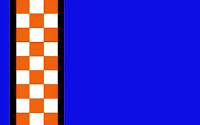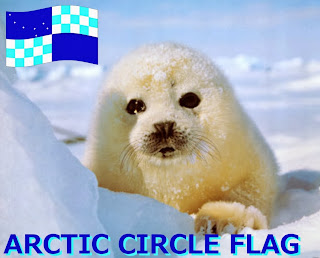
The Equator Flag can be flown officially at the Equator. Thus the nations of Ecuador, Peru, Columbia, Brazil, Gabon, Little and Large Congo, Uganda, Kenya, Somalia, Indonesia have the right to fly this flag on land at their appropriate places. Likewise this flag can be flown under 1 degree North or South.
The Equator Flag has a white background with a red checker stripe in the middle. It is bounded by to the top and bottom with black and yellow sandwich stripe.
The checker pattern denotes a sense of victory as when one crosses the finish line. Typically race cars get a black and white checker flag to signal their final lap when they are about to cross the finish line. Likewise when people cross the equator they are crossing a natural geological line worthy of a victory dance.
-------------------------------
photo credit: taken by Husond, en:Image:Equator_São_Tomé.JPG, enwp upload on 02:00, 14 October 2006
 Of vexillological interest are the three flags on the mastheads. Near the back end of the ship or 'Rudder Mast' is a red pennant with white circular design near the hoist. On the 'Central Mast' is horizontal tribar, starting from the hoist: red, blue, and green. And finally on the 'Forward Mast' is a longer blue swallow tail pennant.
Of vexillological interest are the three flags on the mastheads. Near the back end of the ship or 'Rudder Mast' is a red pennant with white circular design near the hoist. On the 'Central Mast' is horizontal tribar, starting from the hoist: red, blue, and green. And finally on the 'Forward Mast' is a longer blue swallow tail pennant. 













